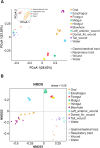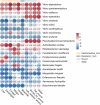Vibrio spp.: a potential critical pathogen for mammals with implications beyond marine aquaculture
- PMID: 41039239
- PMCID: PMC12492875
- DOI: 10.1186/s12866-025-04284-x
Vibrio spp.: a potential critical pathogen for mammals with implications beyond marine aquaculture
Abstract
Background: Species-specific or health status specific microbiome composition of cetaceans is still poorly classified due to the limited samples. Despite a partial identification of the gut microbiota of melon-headed whales (Peponocephala electra), comparative analyses across anatomical systems are lacking. This study provides the first comprehensive analysis of the microbial communities habiting nine body sites - oral cavity, esophagus, foregut, midgut, hindgut, blowhole, and skin wounds (left anterior, dorsal fin, tail) - in a stranded melon-headed whale.
Results: By 16 S rRNA gene sequencing, a decrease in microbial richness was observed from the oral cavity to the hindgut, accompanied by compositional shifts from Fusobacterium-dominated oral/esophageal niches to Vibrio-enriched gastrointestinal regions (21.81% Vibrio, 21.19% Fusobacterium, 12.50% Actinobacillus). The respiratory tract microbiota underwent a significant shift and was dominated by Ostreibacterium (57.5%), Helcococcus (6.59%), and Tenacibaculum (4.12%). Skin wounds showed environmental similarities, with Vibrio (47.84%), Pseudoalteromonas (17.84%), and Psychrobacter (12.36%). Pan-microbiome screening identified seven Vibrio species (V. alginolyticus, V. cidicii, V. cyclitrophicus, V. navarrensis, V. parahaemolyticus, V. salilacus, and V. splendidus) across all niches, along with V. cholerae in non-respiratory samples. Notably, V. profundi was exclusively localized to anterior and dorsal fin wounds. Functional profiling revealed enrichment of Vibrio-linked pathogenesis pathways (infection, pathogenic cycle) and metabolic modules that were correlated with immunocompromised states.
Conclusions: This study revealed significant bidirectional environment-host microbiome exchange dynamics across cetacean mucosal surfaces. Notably, Vibrio spp. emerged as the dominant genus in both gastrointestinal and cutaneous wound microbiomes, highlighting: (1) potential zoonotic transmission risks from pathogenic Vibrio strains, and (2) the critical need for habitat-specific microbial surveillance to inform marine mammal conservation strategies.
Keywords: Gastrointestinal tract; Melon-headed whale; Pathogens; Respiratory tract; Wound.
© 2025. The Author(s).
Conflict of interest statement
Declarations. Ethics approval and consent to participate: The sample collection was approved by the Animal Ethics Committee in Shantou University by project “Possible causes of death of marine mammals, from 2022.01-2027.12”. Consent for publication: Not applicable. Competing interests: The authors declare no competing interests.
Figures






References
-
- Apprill A. Marine animal microbiomes: toward Understanding Host–Microbiome interactions in a changing ocean. Front Mar Sci. 2017;4. 10.3389/fmars.2017.00222.
-
- Perryman WL, Danil K. Melon-Headed Whale. In: Encyclopedia of Marine Mammals. Edited by Würsig B, Thewissen JGM, Kovacs KM: Academic Press; 2018: 593–595. 10.1016/b978-0-12-804327-1.00171-0
-
- Rodrigues Hoffmann A, Proctor LM, Surette MG, Suchodolski JS. The microbiome: the trillions of microorganisms that maintain health and cause disease in humans and companion animals. Vet Pathol. 2016;53(1):10–21. 10.1177/0300985815595517. - PubMed
MeSH terms
Substances
Grants and funding
LinkOut - more resources
Full Text Sources
Miscellaneous

